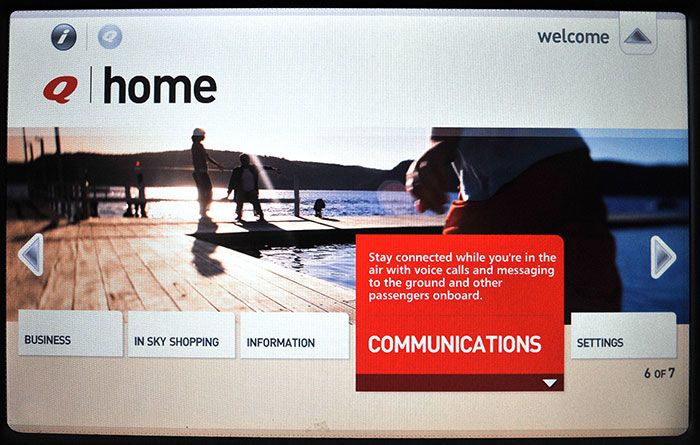How to find a flight with inflight internet, anywhere in the world.
Aside from the wonder of sitting in a chair flying through the air, inflight internet is one of the great wonders of the world. But how does it work -- and which airlines offer it? We have the answers.
Let's face it -- one of the things travelers, airports and airlines invest a lot of effort on is filling in all those hours in the air enjoyably. Whether it's books, magazines, e-readers, iPods or seat-back movies and TV shows, there are plenty of ways of doing it.
But there's no escaping the fact that whatever you take onto the plane is the limit of what you're going to be able to access for the next however-many-hours.
Inflight internet promises a live connection to the outside world, allowing you to browse the web, chat with friends and family, watch streaming TV (on some airlines) and do research and access work resources so you can make use of the time in the plane to knock over some long-overdue work tasks.
Despite the wonderful promise of internet on the plane, airlines and aircraft makers have struggled to make it a commercial success. Boeing famously invested over $1billion in its Connexion satellite internet system, then shut the whole thing down in 2006 after the board decided it had burned enough money on something that wasn't taking off.
It was a textbook case of poor execution, though -- airlines that offered it had scant information onboard about how to use it, very little marketing was done to make the public aware of it, and it was probably a little ahead of its time -- in 2006, smartphones were still very much an enthusiast thing, mobile broadband was still very expensive, and people weren't as used to having 'internet everywhere' as they are now.
Skipping forward a few years to 2010, inflight internet is once again on the agenda and is actually available through several airlines. Australia has been slow to get it, because the communication regulator, ACMA, has inexplicably dragged its heels in approving the use of internet connectivity to aircraft in Australian airspace.
However, Qantas' flagship Airbus A380s clearly have internet coming -- the Panasonic inflight entertainment system has a web browser and internet capability there; there's WiFi installed in the plane for wireless devices, and every seat has a plug-in Ethernet port. The only problem? The planes aren't actually hooked up to the net yet.
A Qantas spokesperson confirmed to Australian Business Traveller that it does plan to offer internet in its A380s, though it had nothing to say at the moment about when it would be activated, or at what price. She also said Qantas had no plans to announce for internet connectivity in its other planes such as its domestic fleet.
Inflight internet on Australian domestic flights
There hasn't been a great deal of action around offering inflight internet within Australia -- though it's likely that all the airlines are keeping their plans as quiet as possible for competitive advantage.
Qantas trialled a single domestic aircraft with onboard mobile phone picocells -- essentially tiny, low power mobile phone base stations. The system was provided by Norwegian firm Aeromobile. Passengers' phones could connect to the base stations at a very low power for GPRS data communication and SMS, rather than the high power they'd have to use while attempting to communicate with ground base stations. The pricing for the service was at global roaming rates for the Qantas flying "country", even though the plane never left Australia.
ACMA gave this sort of inflight mobile telephony system the green-light for broader implementation in July this year, but it was met by strong protest from Telstra, which said it would restrict passengers to using one provider and cost passengers more than it need to. It said Australian mobile networks were already capable of handling communication with passengers on planes. It suggested airlines should simply provide a link between the plane and the ground, allowing passengers to use their existing mobile network, with the airline charging a flat fee of $10 or $15 per flight.
"Australia has a thriving and highly competitive mobile market and there is no reason why it shouldn't extend to the skies as well," Telstra said in a submission to ACMA. It asked Qantas and other airlines to a round-table discussion with Telstra, and there has been very little by way of public comment from any party since.
Inflight internet on flights out of Australia
Inflight internet on Singapore Airlines
Singapore Airlines is the most promising option for Australians wanting to stay connected inflight on flights leaving Australia. It will start offering both WiFi and GSM/GPRS internet for smartphones that don't have WiFi in "the first half of 2011". It will appear first on the new A380s, but will also be installed in Singapore's Airbus A340-500 and Boeing 777-300ER aircraft.
Previously, Singapore had offered Boeing's Connexion inflight internet system in 2005, but this new system will be offered by Airbus/SITA's OnAir system, which uses an Inmarsat's SwiftBroadband satellite connection to the plane. Unfortunately, the Inmarsat link only provides a 432Kbit/s connection to the whole plane.
Singapore Airlines hasn't yet confirmed how much inflight net will cost, but has said that GPRS usage will be billed at international global roaming rates, which suggests it will be very pricey (though it is up to each country to decide how much they bill other international telcos -- and Singapore Airlines is effectively a "country" in this context.)
Inflight internet on Emirates
Emirates has announced plans to install the same OnAir system that Singapore Airlines is using onto its 90 A380s -- the largest fleet of A380s of any airline, though the first plane with inflight internet won't come online until June 2012.
Internet access will be via WiFi as well as GSM/GPRS at global roaming rates.
Inflight internet on Lufthansa
Lufthansa is another big international airline with a major commitment to offering inflight internet. It doesn’t fly directly to Australia, though, so any flights you book will be codeshared with Singapore Airlines or Thai Airways to Europe, with Lufthansa connecting you from there. Once Singapore gets its inflight internet up and running, it may well be possible to book a Lufthansa trip and have internet all the way from Australia and throughout the rest of your itinerary.
Like Singapore Airlines, Lufthansa will be offering both WiFi access and GSM/GPRS access for smartphones. The service is provided by Panasonic's eXConnect system, and will be marketed in Lufthansa planes as "FlyNet" from mid 2010. Planes are connected to the internet via satellite, using the microwave Ku-band frequency. The big selling point of Panasonic eXConnect is that it provides speeds of up to 50Mbit/s to the plane, which is claimed to be 100 times faster than Airbus' OnAir system.
"Lufthansa is deliberately focusing on high bandwidth as the main requirement for the unrestricted use of such services as web surfing, email/file transfer including attachments and the Virtual Private Network (VPN). In addition, only wide bandwidth will enable potential future operational applications such as telemedicine for the transmission of a patient's vital parameters to a ground station," Lufthansa said in a statement.
Inflight internet on Cathay Pacific
Hong Kong international airline Cathay Pacific is also planning to install the high-speed Panasonic eXConnect system into its planes (including its discount DragonAir airline) by 2012.
It says it will also offer "eXPhone" which will be an AeroMobile mobile base station similar to what Qantas trialled in Australia, allowing passengers to use smartphones onboard to make voice calls, send SMSes or use the internet at GPRS speeds. Cathay noted that "eXPhone gives the airline flexibility and full control over the services offered including restricting certain services when appropriate."
USA: inflight internet heaven
Flying domestically in the US is an embarrassment of riches when it comes to internet access in the plane. A company called Aircell has installed EV-DO Rev. A base stations pointing at the sky on mobile towers right across continental USA. The inflight internet service is called GoGo, and aircraft from numerous airlines connect to the Aircell base stations and provide inflight internet access via WiFi at affordable rates.
Airlines that offer the GoGo system include: Air Canada, AirTran Airways, Alaska Airlines, American Airlines, Delta Air Lines, United Airlines, US Airways, Virgin America and soon, Frontier Airlines.
However, not all planes with the airlines have the GoGo equipment installed yet. Virgin America has it on all their planes -- but they only have a few planes flying selected routes.
One month of unlimited GoGo use costs $US34.95, though it's on special at the time of writing for $US19.95, while single flight passes can cost as little as $US4.95 for a flight up to 1.5hrs.
Southwest Airlines also has its own satellite-based inflight internet system on some of its planes, using the "Row 44" system, which in turn uses HughesNet satellite internet. It will cost $5 for any flight length, which is significantly cheaper than the GoGo system, except for short flights.
JetBlue will be offering inflight internet using the Viasat system -- though it's not available yet.
There's a handy website called HasWiFi which can help you find a flight in the US that has WiFi at a time that suits your schedule.
We want your experiences!
If you have recently flown on a plane that included inflight internet please comment below on how much you paid, which airline/flight it was, and how you found the performance and ease of use. It's a rapidly developing area, and first-hand experiences are absolutely invaluable.


Hi Guest, join in the discussion on Inflight internet - what you need to know